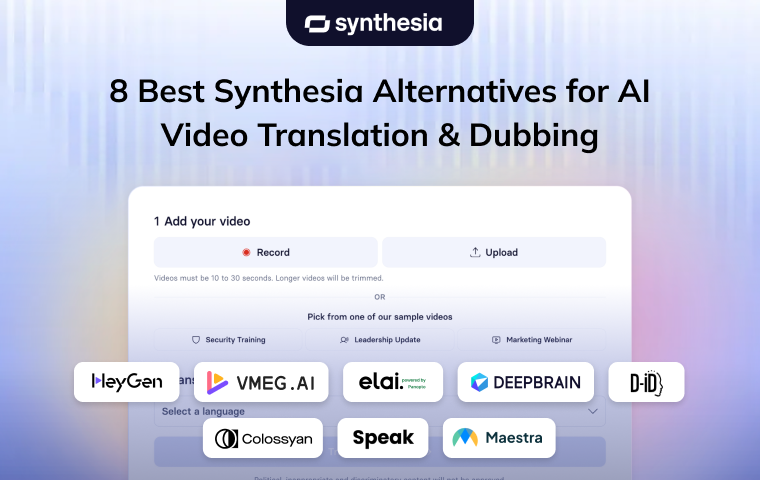
AI video translation and dubbing tools are transforming the way creators, educators, and worldwide teams interact. Instead of paying multilingual voice actors or manually re-editing videos, modern AI platforms can translate, dub, and lip-sync videos in numerous languages in minutes, replete with realistic cloned voices and correct subtitles.
While Synthesia is still a popular choice for avatar-based video creation, its limits in voice cloning, language coverage, and advanced dubbing have prompted many pros to look into more powerful, localization-ready alternatives.
In this post, we'll examine the top 8 Synthesia options for AI video translation and dubbing in 2025, analyzing each application based on language compatibility, realism, localization quality, and usability.
Why Look for Synthesia Alternatives?
Synthesia is an artificial intelligence video-generating platform that allows people to make talking avatar videos from text without the need for cameras or performers. It supports several languages, has realistic presenters, and simple editing capabilities, making it ideal for training, marketing, and business communication.
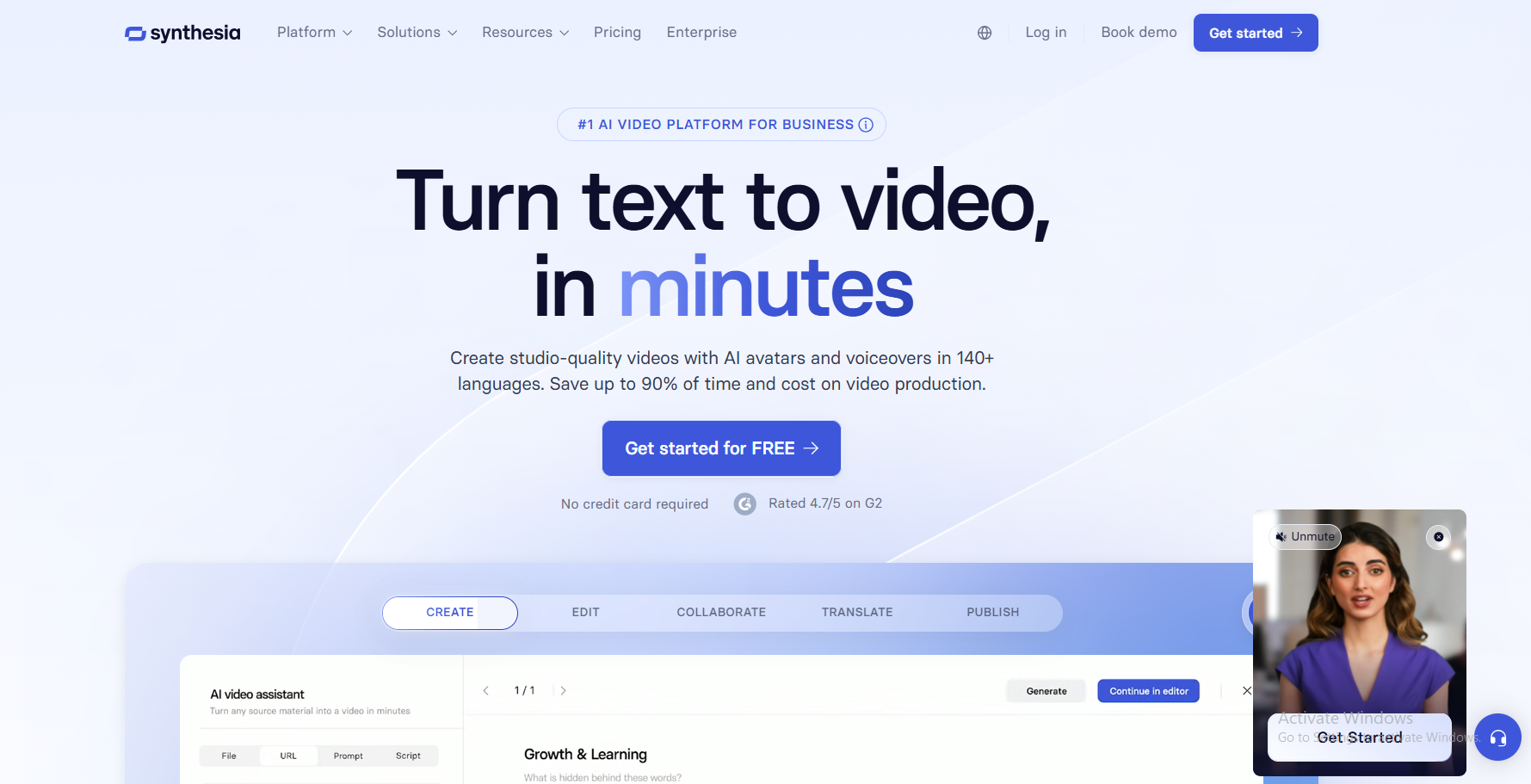
However, its primary concentration is on avatar-based video creation rather than large-scale translation or dubbing procedures. Here’s why many people are switching to newer dubbing-focused platforms:
- Limited Voice Cloning: You can’t replicate your own or your team’s voices for natural-sounding multilingual dubbing.
- Basic Translation Options: Synthesia supports text-to-speech in multiple languages but lacks context-aware translation or editable subtitles.
- No Real Lip-Sync for Dubbed Voices: Lip movements often remain tied to the original English track, which affects authenticity.
- High Cost for Enterprise Localization: Advanced export options, long video support, and high-quality avatars can quickly increase costs.
If your goal is to translate, dub, and localize your video content across global audiences, the following alternatives deliver more advanced functionality.
The 8 Best Synthesia Alternatives in 2025
Based on market research and competitor comparisons, here are the 9 top Synthesia alternatives worth considering this year.
VMEG AI – Best for Localization & Enterprise Video
VMEG AI is a next-generation AI video localization platform built for global teams and enterprises. It enables seamless dubbing, translation, and voice cloning across 170+ languages with 7,000+ realistic voices, helping organizations communicate globally with precision and style.
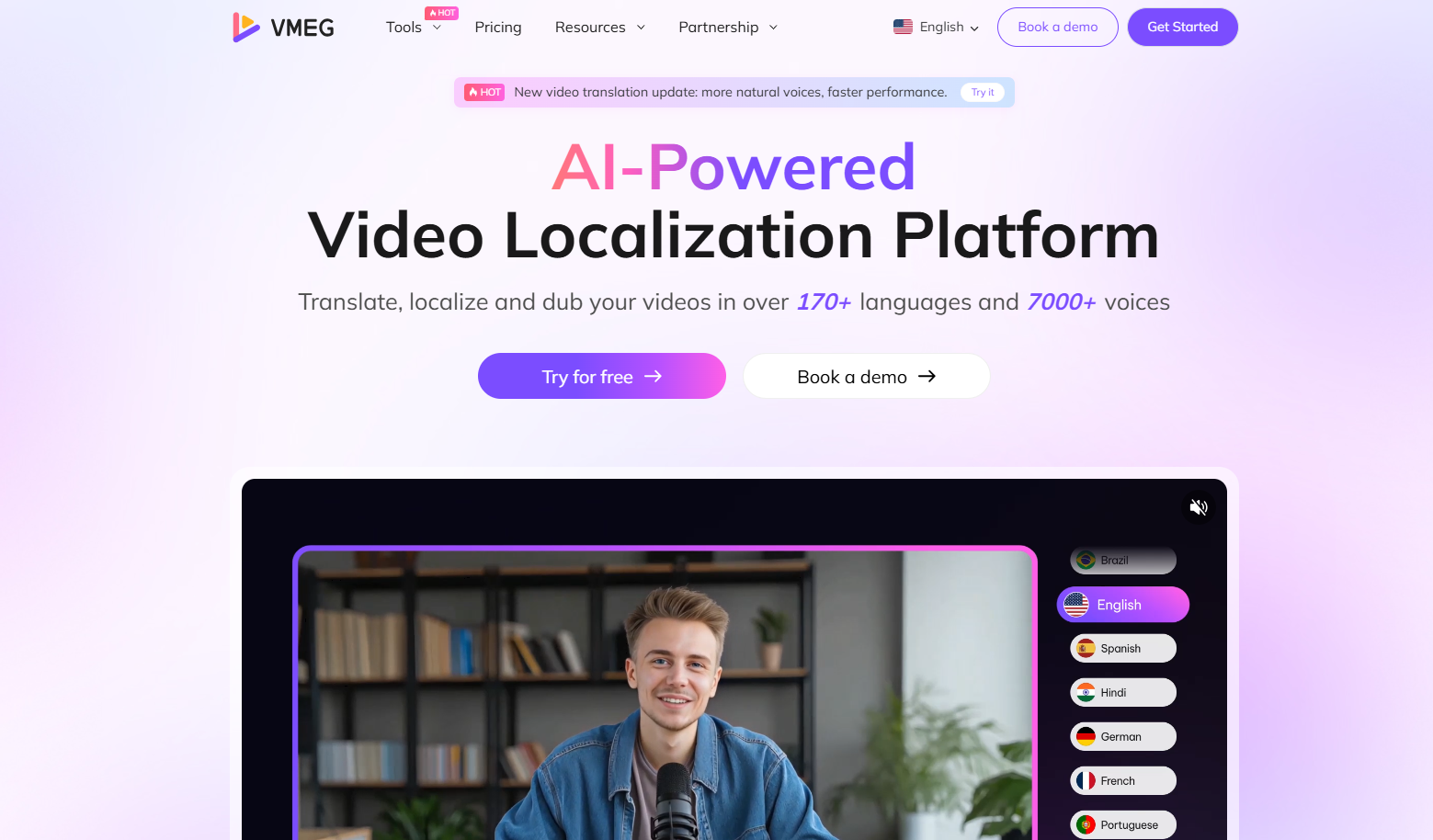
Key Features:
- 170+ languages and 7,000+ realistic voices with natural intonation.
- Customizable subtitles, voice tones, and branding options (logos, templates).
- Flawless Lip-Sync: Perfectly synchronized mouth movements for natural results.
- AI Subtitle Translator: Auto-generate and edit multilingual subtitles with full customization.
- Enterprise-Ready: Scalable for localization teams and media studios.
Strengths:
- Unmatched multilingual dubbing coverage.
- Extremely realistic voice quality and synchronization.
- Supports both individual creators and enterprise workflows.
Weaknesses:
- A newer platform than Synthesia, so community resources are smaller.
- Some advanced localization tools have a learning curve.
Best For:
- Global enterprises produce multilingual content.
- Training, onboarding, and internal communication videos.
- Marketing and localization projects requiring natural AI dubbing.
Elai.io – Best for E-Learning Localization
Elai.io is an intuitive AI video generator that simplifies the process of turning text, slides, or scripts into training videos. It supports over 75 languages and offers customizable avatars — making it ideal for companies creating internal learning materials for global teams.
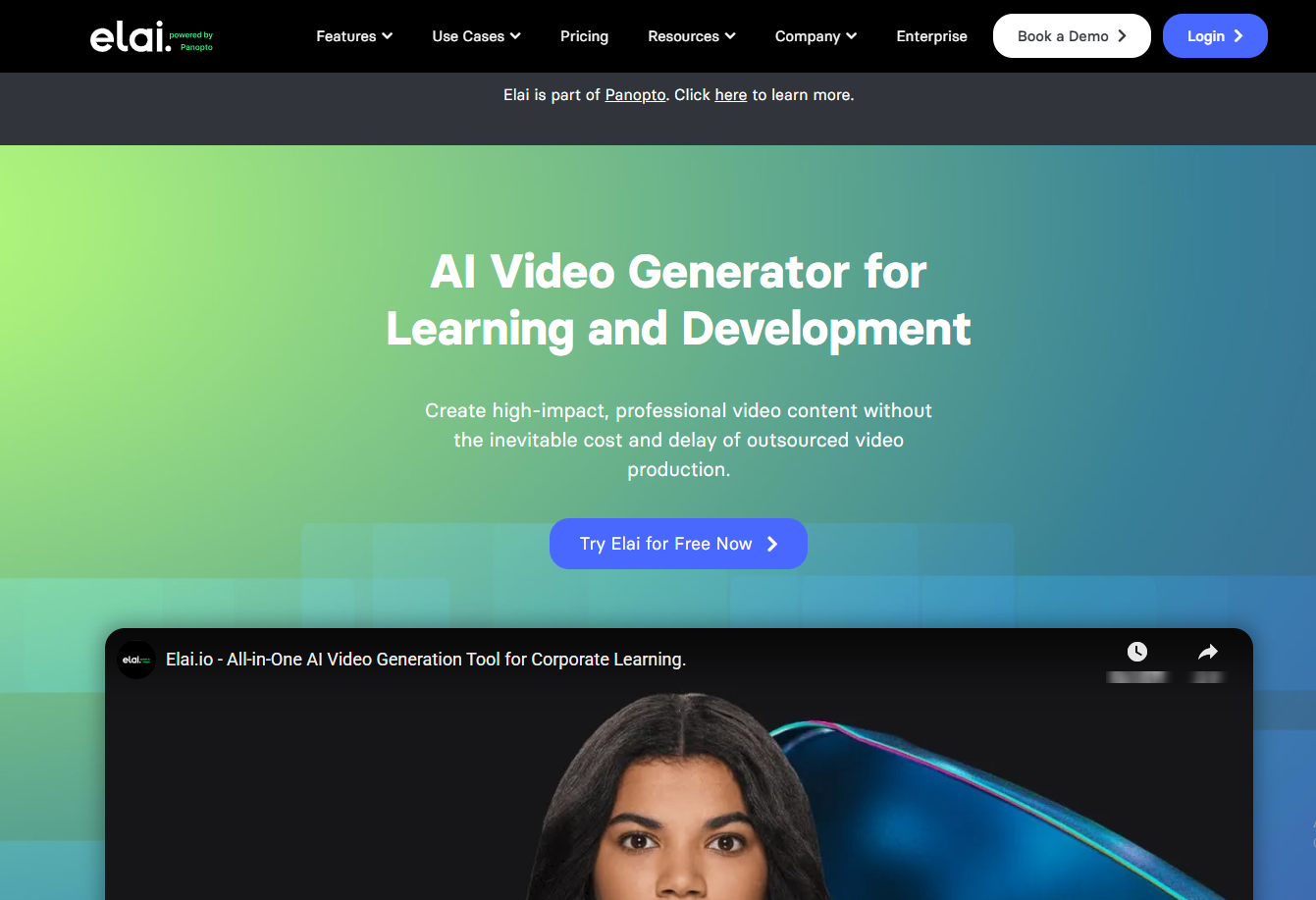
Key Features:
- Text-to-video generation from scripts or URLs.
- 75+ supported languages with clear voiceovers.
- Custom avatars and branded templates.
- Subtitle auto-generation and translation options.
Strengths:
- Simple drag-and-drop video builder.
- Excellent for localized learning or onboarding videos.
- Offers integrations with e-learning systems.
Weaknesses:
- No voice cloning or emotional tone control.
- Lip-sync accuracy is less advanced than VMEG AI.
Best For:
- HR and corporate training localization.
- Educational institutions producing multilingual lessons.
HeyGen – Best for Marketing & Social Media Localization
HeyGen focuses on quick, engaging video creation for creators and marketing teams. With dozens of avatars and an intuitive interface, it’s ideal for fast content localization across social media platforms — although its dubbing and voice options are less advanced.
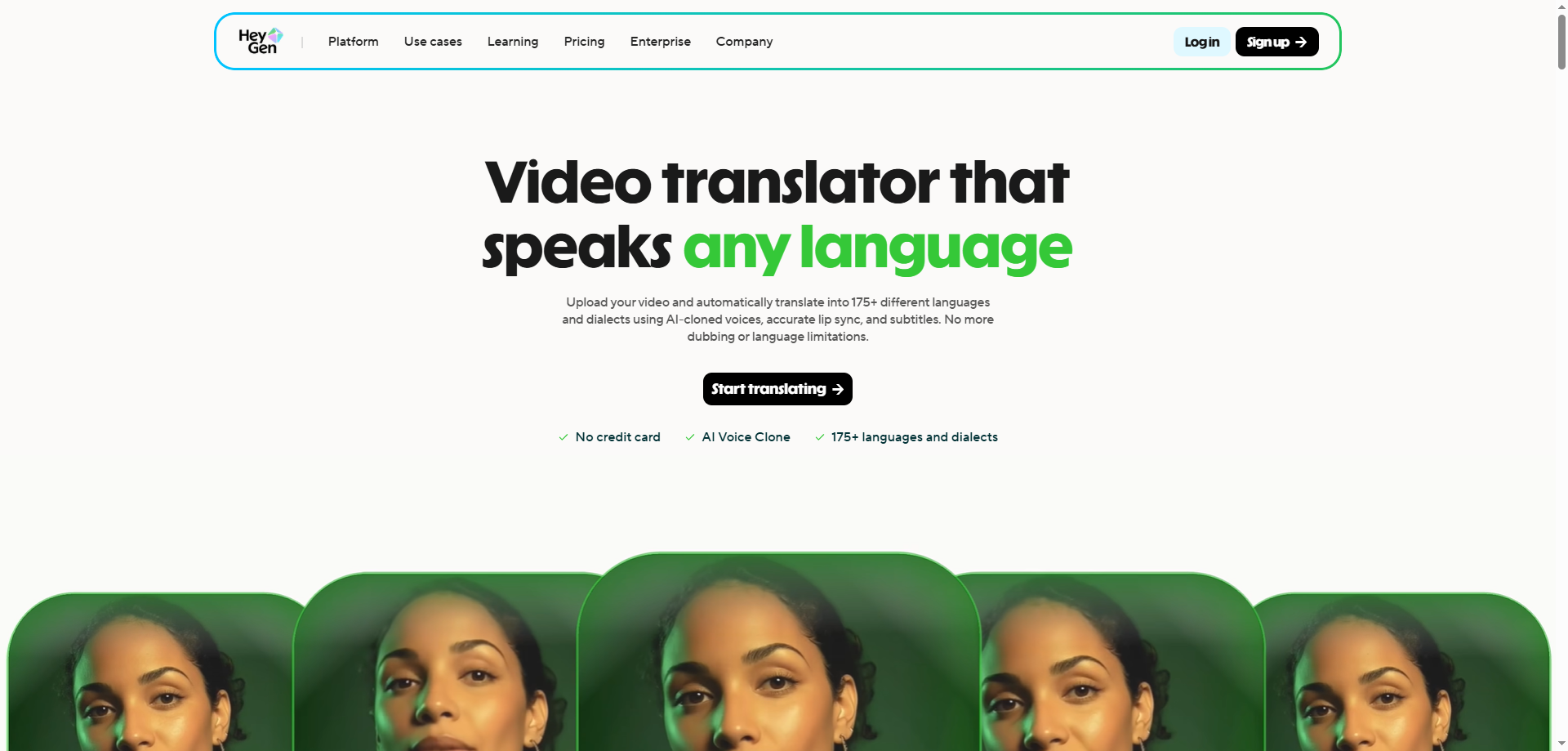
Key Features:
- Text-to-video creation in 40+ languages.
- Dozens of avatars with natural movements.
- User-friendly online editor and templates.
- Supports multilingual subtitles.
Strengths:
- Extremely easy for beginners.
- Great for marketing videos and ad localization.
- Affordable for individuals and small teams.
Weaknesses:
- Limited voice library and language coverage.
- No voice cloning or advanced dubbing sync.
Best For:
- Social media localization.
- Marketing teams producing fast-turnaround videos.
DeepBrain AI – Best for Professional Corporate Localization
DeepBrain AI (the company behind AI Studios) offers one of the most realistic AI avatar systems available today. It’s widely used by corporations, broadcasters, and government agencies for multilingual video communication and localization. With lifelike avatars and precise dubbing synchronization, it’s ideal for professional environments that demand authenticity and control.
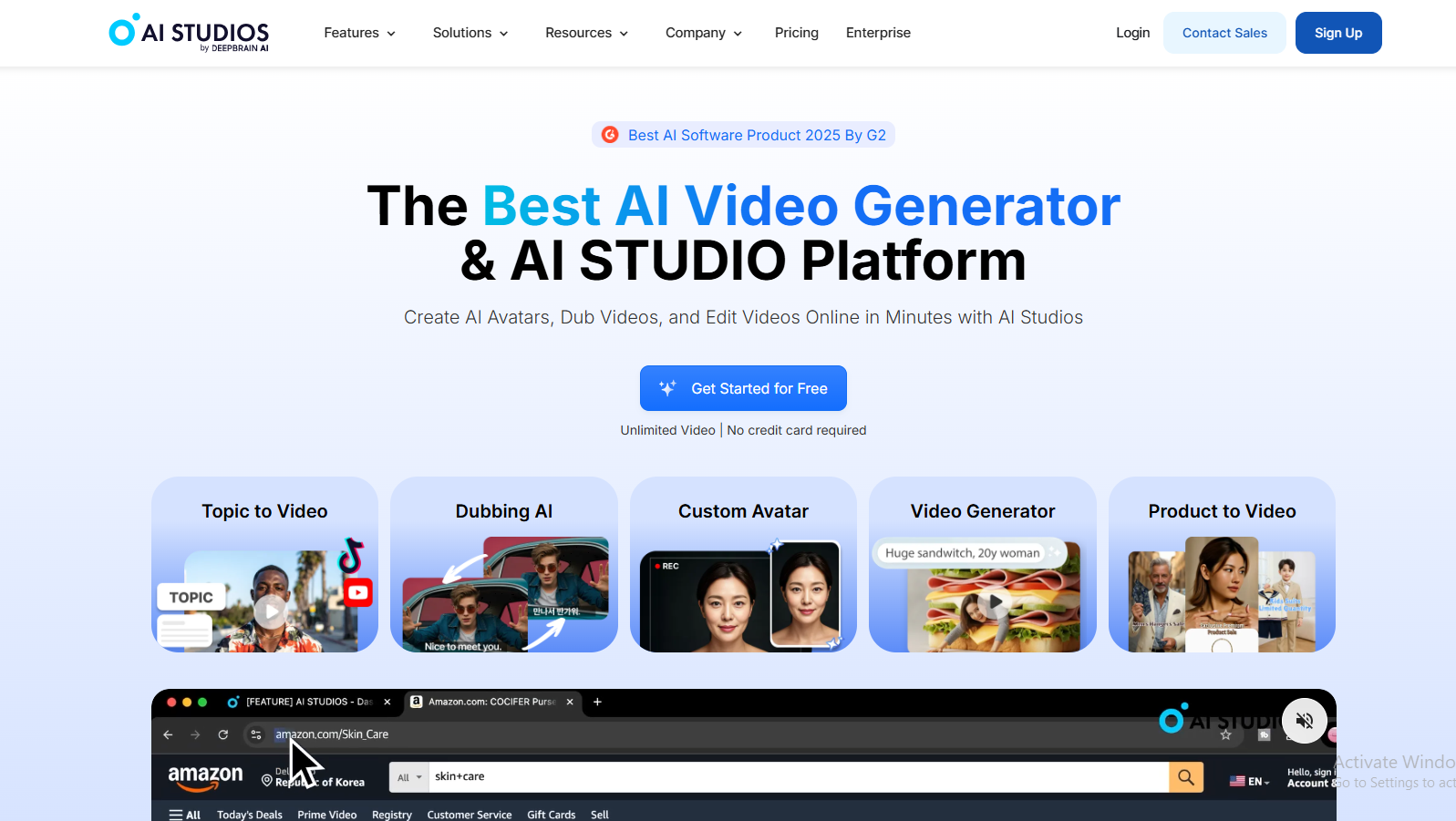
Key Features:
- Hyper-realistic avatars with accurate lip-sync and gestures.
- Supports 80+ languages with localized voiceovers.
- Secure enterprise deployment and API integrations.
- Custom branding and visual style options for corporate identity.
Strengths:
- Broadcast-grade avatar realism and dubbing accuracy.
- Trusted by enterprises and government institutions.
- Strong localization and professional output quality.
Weaknesses:
- Higher pricing tier.
- More complex setup and onboarding process.
Best For:
- Corporate communications and multilingual announcements.
- Government, news, and institutional localization projects.
Maestra – Best for Subtitles & Voice Dubbing
Maestra AI is best known for its subtitle and dubbing automation features. It’s not avatar-based — instead, it focuses on creating localized versions of existing videos through accurate translations, transcripts, and multilingual voiceovers.
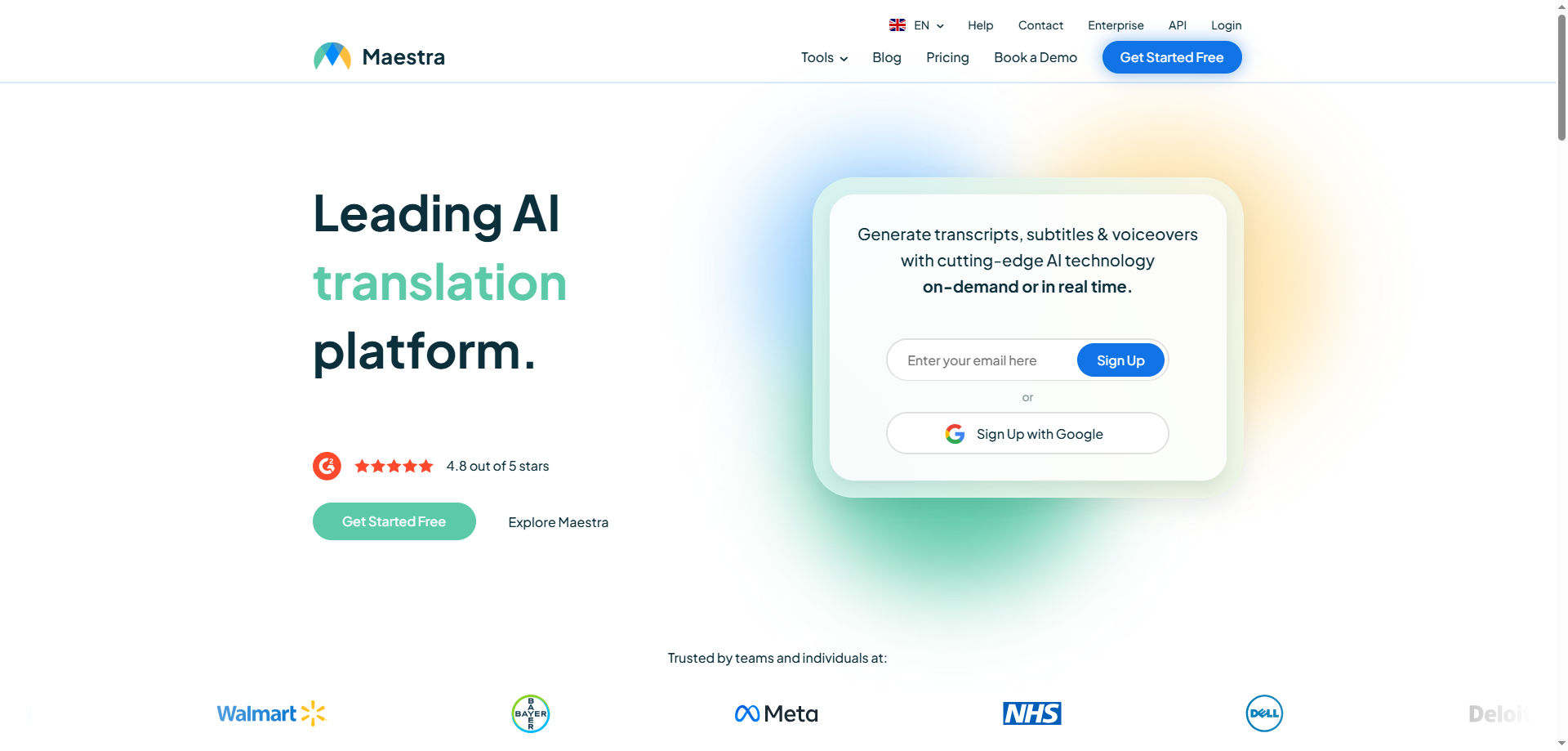
Key Features:
- Auto-transcribe and translate audio/video into 80+ languages.
- AI dubbing with natural voices.
- Supports subtitles (SRT, VTT, burned-in).
- Integrations for YouTube, TikTok, and enterprise tools.
Strengths:
- Excellent subtitle translation accuracy.
- Multi-speaker dubbing support.
- Ideal for media localization workflows.
Weaknesses:
- No avatars or visual generation.
- Lip-sync quality moderate (voice-first focus).
Best For:
- YouTube localization.
- Subtitle-heavy video projects.
- Teams needing large-scale dubbing automation.
Speak AI – Best for Automatic Translation & Dubbing
Speak AI focuses on multilingual video translation, dubbing, and transcription. It’s ideal for businesses and creators who want to convert existing videos into multiple languages with synchronized subtitles and natural AI voices.
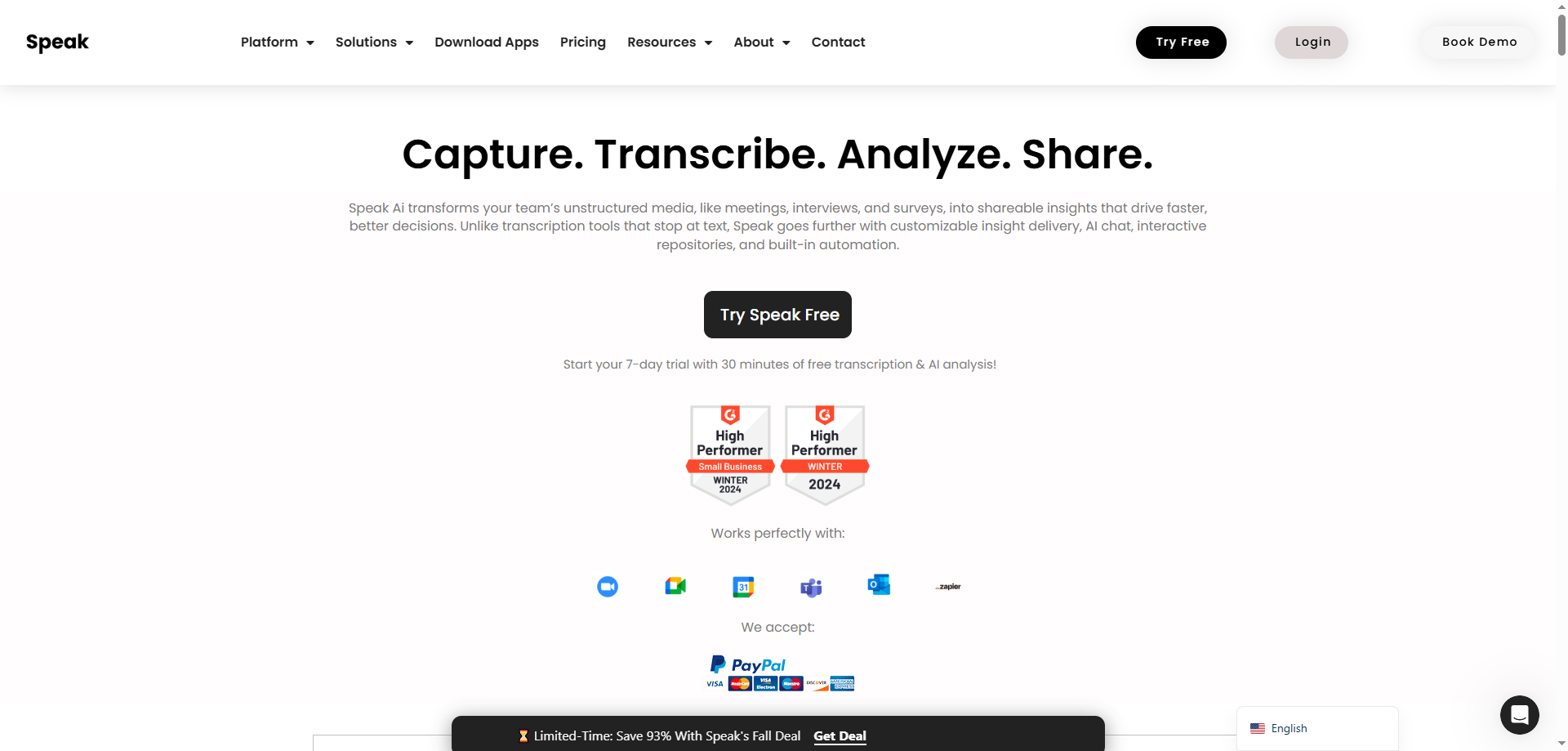
Key Features:
- Automatic speech recognition (ASR) and subtitle translation in 100+ languages.
- AI voice dubbing that maintains tone and timing accuracy.
- Text, audio, and video translation tools in one dashboard.
- Cloud-based editor for reviewing and refining transcripts or voiceovers.
Strengths:
- Strong in translation, dubbing, and subtitle synchronization.
- Great for multilingual podcasts, lectures, and corporate content.
- Easy-to-use interface with export options for multiple formats.
Weaknesses:
- No avatars or talking presenters.
- Less suitable for marketing or visual storytelling projects.
Best For:
- Translating and dubbing educational or corporate videos.
- Content localization for YouTube and internal training.
- Teams focusing on multilingual communication without avatars.
D-ID – Best for Photo-to-Video Translation
D-ID stands out with its photo animation technology that transforms still images into talking videos. While not built for enterprise dubbing, it’s excellent for creative storytelling, educational projects, and quick multilingual explainers.
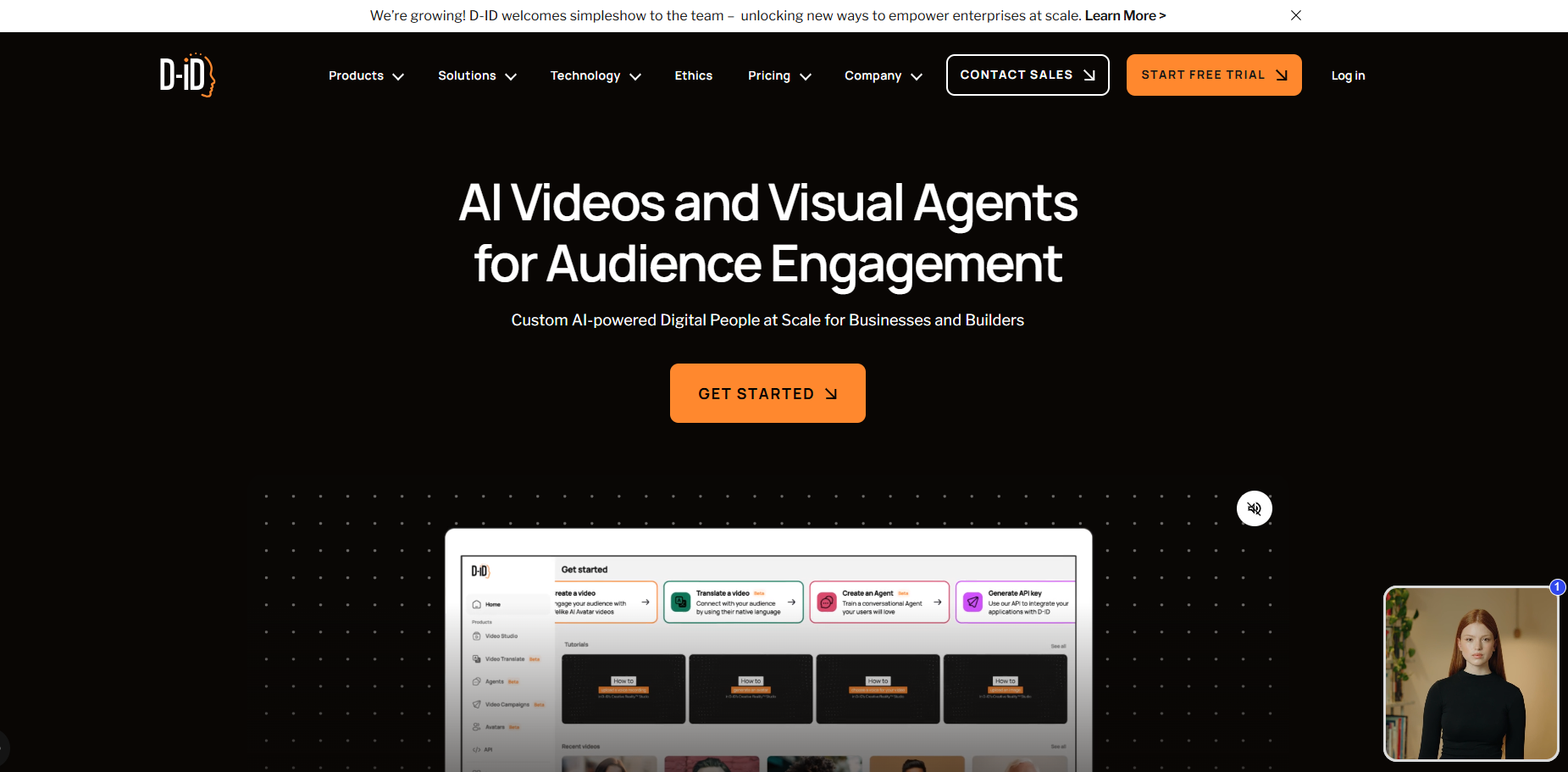
Key Features:
- Convert portraits or photos into talking videos.
- Supports text-to-speech in 30+ languages.
- AI facial animation with basic lip-sync.
- Simple, browser-based workflow.
Strengths:
- Unique and creative use of AI.
- Fast rendering and easy to use.
- Ideal for historical, artistic, or personalized content.
Weaknesses:
- Limited editing and dubbing options.
- Not suited for enterprise localization.
Best For:
- Quick talking head videos.
- Creative storytelling or education projects.
Colossyan – Best for E-Learning and Training Translation
Colossyan focuses on AI-generated training and explainer videos with strong multilingual support. It’s often used for employee training and corporate e-learning localization, combining simple text-to-video workflows with translation features.
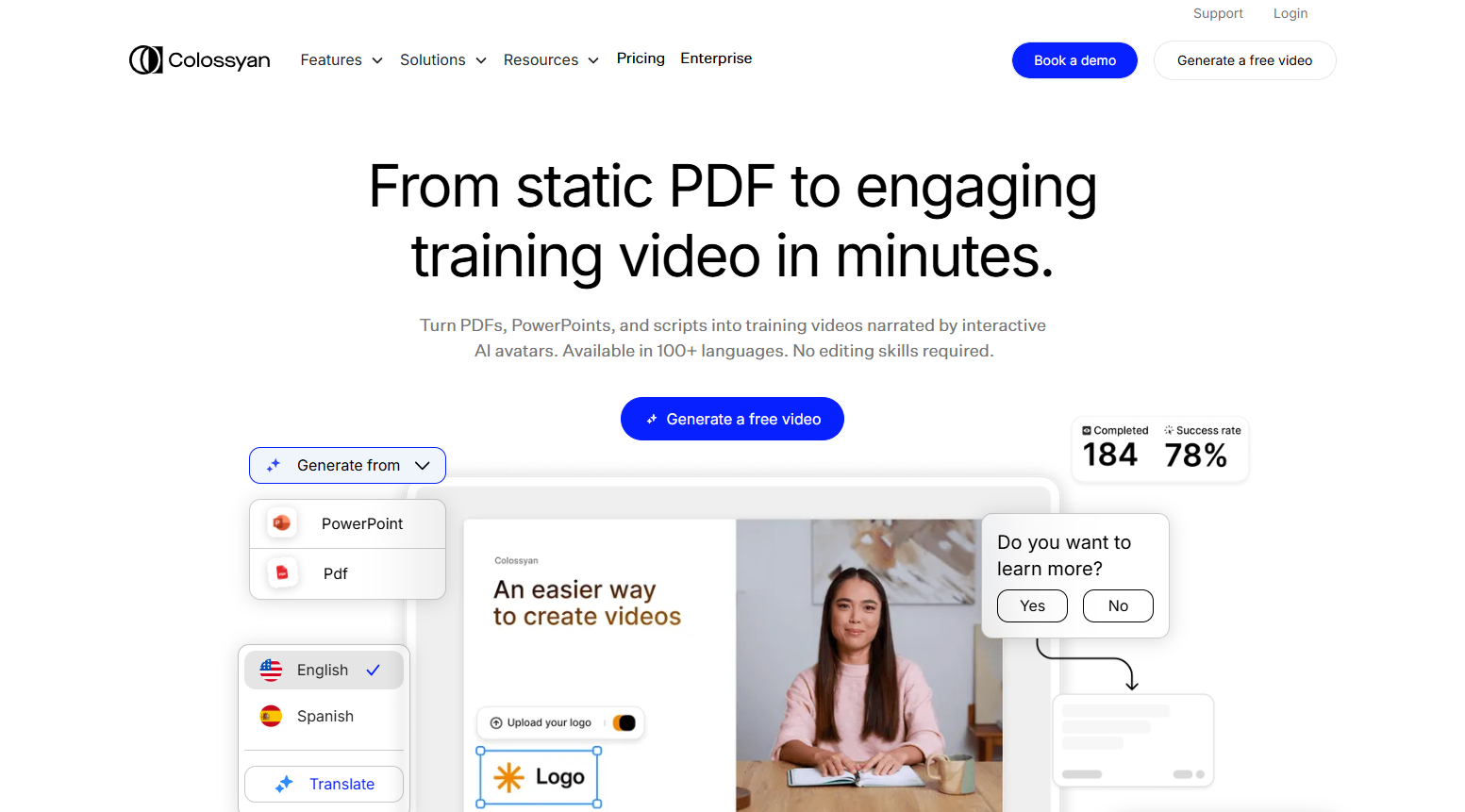
Key Features:
- Script-to-video generation with AI avatars.
- 70+ languages supported with translated voiceovers.
- Custom branding and scene templates.
- Integration with learning management systems (LMS).
Strengths:
- Great for multilingual corporate and compliance training.
- Consistent dubbing quality with adjustable tones.
- Supports subtitle translation and editing.
Weaknesses:
- Avatars are less realistic than VMEG AI or DeepBrain AI.
- Voice cloning and emotional nuance are limited.
Best For:
- HR, corporate training, and multilingual onboarding.
- Internal communication localization.
Quick Comparison: Best AI Video Translation & Dubbing Tools
Here’s a quick comparison of the top AI dubbing and localization tools, highlighting their strengths in language support, lip-sync quality, and subtitle translation capabilities.
| Tool | Best For | Language Coverage | Lip-Sync | Subtitle Translation |
| VMEG AI | Enterprise localization & dubbing | 170+ | ★★★★★ | Yes |
| Elai.io | E-learning translation | 75+ | ★★★★☆ | Yes |
| HeyGen | Marketing localization | 40+ | ★★★☆☆ | Partial |
| DeepBrain AI | Corporate communication | 80+ | ★★★★★ | Partial |
| Maestra AI | Subtitle & dubbing automation | 80+ | ★★★☆☆ | Yes |
| Speak AI | Translation & dubbing automation | 100+ | ★★★★☆ | Yes |
| D-ID | Photo-to-video translation | 30+ | ★★☆☆☆ | No |
| Vozo AI | Fast dubbing & lip-sync | 100+ | ★★★★★ | Yes |
| Colossyan | E-learning translation | 70+ | ★★★★☆ | Yes |
What to Look For in a Good Synthesia Alternative
When choosing an alternative to Synthesia with translation and dubbing in mind, focus on:
- Language and Voice Support: The more languages and natural voice tones available, the better your global reach.
- Lip-Sync Precision: Tools like VMEG AI and Vozo.ai offer highly accurate lip synchronization, improving realism.
- Subtitles and Transcripts: Ensure automatic subtitle translation and export in SRT/VTT for accessibility.
- Customization & Branding: Choose tools that let you add logos, templates, or localized styles.
- Integration Options: LMS, CMS, or API support for streamlined localization workflows.
- Scalability: Enterprise tools like VMEG AI scale better for large multilingual projects.
FAQs
Is there a free alternative to Synthesia?
Yes. Tools like Pictory and Veed.io offer free or low-cost versions, though with limited features compared to Synthesia.
What’s the best Synthesia competitor for e-learning?
Elai.io and VMEG AI are strong options, as they both support integration with learning platforms and multilingual training content.
Which platform is best for multilingual dubbing?
For large-scale multilingual projects, tools that combine translation, voice cloning, and subtitle synchronization — such as VMEG AI, Elai.io, or Maestra.ai — deliver the most consistent results.
Can I automatically dub e-learning or training videos?
Yes. Many AI video tools now allow educators and companies to upload existing lessons and automatically generate dubbed versions for different languages, streamlining global learning delivery.
Which AI offers the most natural-sounding voiceovers?
Platforms likeDeepBrain AI, VMEG AI, and Rephrase.ai are known for lifelike, context-aware speech generation, making them suitable for professional or educational use.
Conclusion
Synthesia is still a solid AI avatar generator, but it lacks advanced dubbing and translation features essential for global communication. For multilingual video creation, VMEG AI leads with its all-in-one localization system combining dubbing, translation, subtitles, and voice cloning.
Maestra.ai excel in fast dubbing, while Colossyan and Elai.io specialize in e-learning localization. DeepBrain AI stands out for professional corporate videos. Among them, VMEG AI remains the most complete solution for seamless multilingual production.
Maestra.ai excel in fast dubbing, while Colossyan and Elai.io specialize in e-learning localization. DeepBrain AI stands out for professional corporate videos. Among them, VMEG AI remains the most complete solution for seamless multilingual production.
Localize Your Videos Instantly with VMEG AI
Translate, dub, and subtitle your videos into 170+ languages using 7,000+ realistic voices — complete with voice cloning, perfect lip-sync, and auto-subtitles.
